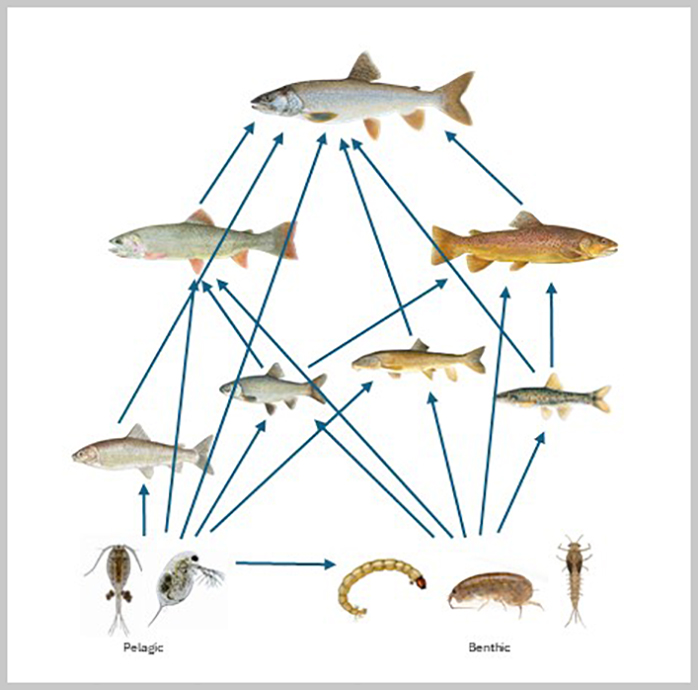Aquatic ecosystem production in Jackson Lake – part 2
Published February 21, 2025
By Tristan Blechinger
This two-part blog post is adapted from a presentation held in December 2024. Presenters and authors: Sean Bertalot, student with Sarah Collins studying limnology and ecosystem ecology in Jackson Lake. Tristan Blechinger, student with Willie Fetzer studying fisheries, food web ecology in Jackson Lake and elsewhere. back to part 1
Identifying drivers of food web stability and fisheries productivity
Tristan Blechinger: "There are a lot of variables that influence the availability of aquatic habitats like water clarity, temperature, and dissolved oxygen. In reservoirs specifically, water level is also an important driver of habitat availability. As water levels fluctuate, the area and volume of habitats like the nearshore littoral zone can change a lot.
When we're connecting habitat availability to food web structure and function, it’s important to understand the role that unique resources (e.g., benthic algae in the nearshore habitat versus plankton in the open water habitats) play in supporting higher trophic level species. To do this, we’re using stable isotopes to quantify the energy pathways supporting the Jackson Lake fishery. These data quantify the amount of energy, or carbon, that individual fish are acquiring from these different basal energy sources as well as the trophic position they are occupying within the food web. Mapping the food web in this way allows us to identify resource use, competition, and predation between popular species like Lake Trout, Brown Trout, and Snake River Cutthroat Trout.
Currently, these species are doing well and successfully cohabitating Jackson Lake. However, the Wyoming Game and Fish Department, who are collaborators on this project, are concerned about potential competition between Brown Trout and Snake River Cutthroat trout as well as consumption of Snake River Cutthroat trout by Lake Trout. Understanding current food webs dynamics, as well as how potential changes in habitat availability, and therefore resource availability, may influence food web dynamics will allow for more informed management of these recreationally and economically valuable species.

Jackson Lake food web
Top: Lake Trout
Second row: Snake River Cutthroat Trout (left), Brown Trout
Preliminary data suggest Brown Trout and Snake River Cutthroat Trout occupy highly overlapping niches, so they use a lot of the same resources within Jackson Lake. These resources appear to be comprised primarily of small bodied fish species (e.g., Speckled Dace and Utah Chub) as well as benthic invertebrates and zooplankton. However, they're likely not resource limited as both populations appear to be doing well. Lake Trout have a much bigger niche size, indicating use of a broad range of resources allowing them to escape competition with other species. Lake Trout appear to forage more on Brown Trout than Snake River Cutthroat, with Mountain Whitefish also contributing significantly to their diets. There also appears to be a fairly high amount of individual specialization within the Lake Trout population, which is driving the large population niche size.
In summary, the Jackson Lake food web appears to be pretty balanced. The ‘peak’ of the food web is centered, indicating a nearly equivalent reliance on benthic and pelagic resources. A balanced shape like the one present in Jackson Lake is likely promoting food web stability and high productivity of the fishery. Hopefully, this stable food web shape will encourage a positive response to potential changes in resource availability that may accompany more drastic changes in water levels. As water levels go down and the littoral area is reduced, there will likely be fewer benthic resources to go around. This could result in increased competition between species with similar niches like Brown Trout and Snake River Cutthroat trout. Reductions in cold water habitat volume or increasing water temperatures could also negatively affect Mountain Whitefish, which appear to be an important prey source for Lake Trout.
Beyond Jackson Lake
While we're focusing primarily on Jackson Lake where we've been collecting our data, we can apply these methods to other water bodies as well. By using existing stable isotope data that we've collected from previous Wyoming Game and Fish Department projects, we can look at these patterns across broad spatial scales. We can start to understand what might be driving these food web shapes and place Jackson Lake in the context of other systems to understand how food webs might respond to changing environmental conditions. We can also look at species-specific responses by analyzing the foraging ecology of individual fish. Food web structure is often driven largely by apex predators, commonly Lake Trout or Walleye, and how they forage. Understanding the degree to which individual specialization or generalization is occurring, or how individuals are using resources within an ecosystem, we can start to get an idea of how these species may adapt to environmental disturbances in the future."
